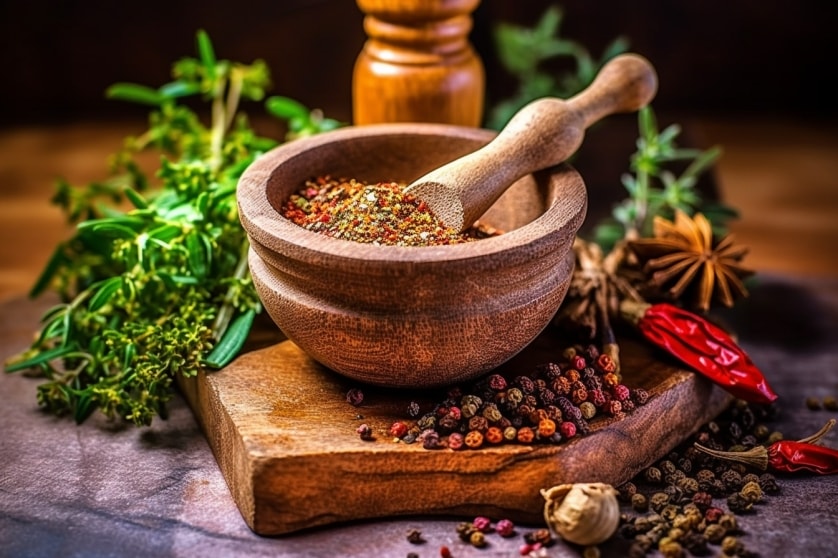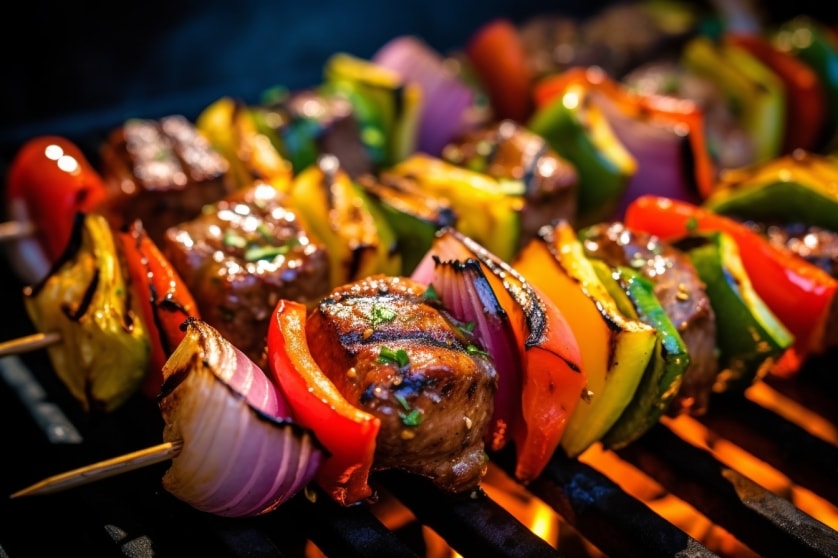Table of Contents
ToggleCaribbean Spice: Jerk Veggie Kabobs for Flavorful Finger Foods
Introduction:
Oh, hello there, fellow flavor adventurers! Today, we’re embarking on a culinary escapade that will transport your little one’s taste buds straight to the sunny shores of the Caribbean. Get ready to add a pinch of spice and a whole lot of flavor to your baby’s mealtime with our tantalizing recipe for Jerk Veggie Kabobs!
Now, I know what you might be thinking. Spicy food for babies? Isn’t that a little risky? Fear not, my dear friends, for we shall navigate this spicy terrain with utmost care and consideration. But first, let’s talk about the allure of Caribbean cuisine and the incredible benefits it holds for our tiny food explorers.
Imagine vibrant markets brimming with exotic fruits, bustling streets filled with the irresistible aroma of sizzling spices, and a symphony of flavors dancing on your tongue. That, my friends, is the magic of Caribbean cuisine. It’s a fusion of African, European, and Indigenous influences, resulting in a kaleidoscope of tastes that will leave your taste buds begging for more.
Caribbean spices, oh how they tickle our senses! We’re talking about the magnificent allspice, with its warm and earthy notes; the fiery scotch bonnet peppers that can bring tears to your eyes (in the best way possible); fragrant thyme that adds a burst of freshness, and garlic that weaves its aromatic spell. It’s a flavor symphony that can make even the tiniest of taste buds come alive!
But why should we limit this culinary adventure to our adult plates? Oh no, my friends, let’s bring the magic of the Caribbean to our little ones’ meals too! By introducing them to the wonders of jerk seasoning, we open up a world of flavors and experiences that will shape their palates and create a lifelong appreciation for diverse cuisines.
Now, you might be wondering, But won’t spicy food upset my baby’s delicate tummy? Fear not, for we shall walk this path together, step by step. We’ll start with gentle flavors, gradually building up their tolerance to spice, and ensuring a delightful culinary journey for both of you.
Oh, the benefits of homemade baby food! Not only does it allow us to control the quality and freshness of the ingredients, but it also opens up a world of culinary possibilities. By incorporating Caribbean spices into our little one’s meals, we provide them with a delightful sensory experience while boosting their nutritional intake.
Think of those vibrant vegetables, bursting with vitamins, minerals, and fiber! Bell peppers, zucchini, cherry tomatoes—these colorful delights are not only pleasing to the eye but also packed with goodness. And when we marry them with the flavors of jerk seasoning, we create a harmonious dish that nourishes both body and soul.
But let’s not forget the magic that happens when our babies encounter new flavors. By introducing them to diverse tastes early on, we expand their culinary horizons and set them on a path towards adventurous eating habits. It’s a gateway to a world of exciting flavors and an appreciation for global cuisines.
So, my fellow flavor enthusiasts, are you ready to embark on this Caribbean culinary journey? Get your aprons on, fire up the grill (or oven if that’s your preferred cooking method), and let’s create a feast fit for the tiniest of food explorers. Our Jerk Veggie Kabobs will transport your baby’s taste buds to a tropical paradise, one delicious bite at a time!

Section 1: Background on Caribbean Cuisine
Picture this: the sun-kissed beaches, the rhythmic beats of the steel drums, and the tantalizing aroma of spices wafting through the air. Welcome to the vibrant world of Caribbean cuisine, where flavors collide and culinary traditions intertwine like a lively dance!
Caribbean cuisine is a melting pot of influences from Africa, Europe, and the Indigenous cultures that have shaped this beautiful region. It’s a culinary tapestry woven with history, heritage, and a whole lot of zest! So, let’s take a deeper dive into the rich background of this captivating cuisine.
Now, when we talk about Caribbean cuisine, we’re not just referring to one single entity. Each island and country within the Caribbean boasts its own unique culinary traditions and flavors. From the fiery spices of Jamaica to the savory stews of Trinidad and Tobago, every destination offers its own delectable treasures.
Let’s start with the African influence. During the era of the transatlantic slave trade, African people brought with them their rich culinary heritage. They infused Caribbean cuisine with flavors like okra, callaloo, and yams, creating dishes that celebrate their roots and provide a taste of their homeland.
Next, we have the European influence. Colonization brought flavors from the Old World, including ingredients like onions, garlic, and citrus fruits. The European culinary techniques blended seamlessly with the vibrant local ingredients, resulting in a unique fusion of flavors that still delights our taste buds today.
And let’s not forget the Indigenous cultures that have inhabited the Caribbean for centuries. They introduced staples like corn, cassava, and peppers, adding their own distinctive touch to the culinary landscape. These ingredients became the building blocks of many traditional Caribbean dishes.
But what truly sets Caribbean cuisine apart is its exceptional use of spices and seasonings. It’s like a flavor explosion in every bite! Caribbean cooks have mastered the art of balancing flavors, using spices like allspice, nutmeg, cinnamon, and ginger to create a symphony of taste that dances on your palate.
One iconic spice blend that immediately comes to mind when we think of Caribbean cuisine is jerk seasoning. Ah, jerk! The tantalizing aroma of smoky goodness mixed with the fiery kick of scotch bonnet peppers—it’s a match made in culinary heaven. Originally hailing from Jamaica, jerk seasoning is a mouthwatering blend of allspice, thyme, scallions, garlic, and of course, those feisty scotch bonnet peppers.
But it’s not just the flavors that make Caribbean cuisine so captivating; it’s the vibrant and welcoming culture that accompanies it. In the Caribbean, food is not just nourishment—it’s a celebration of life, love, and togetherness. It’s the joy of gathering with friends and family, sharing a meal, and creating memories that last a lifetime.
So, whether it’s a hearty plate of jerk chicken, a steaming bowl of callaloo soup, or a refreshing sip of coconut water straight from the source, Caribbean cuisine is a sensory journey that transports you to a world of sun, sand, and pure culinary delight.
Now that we’ve delved into the captivating background of Caribbean cuisine, it’s time to bring those vibrant flavors into our little one’s meals. Get ready, because our Jerk Veggie Kabobs are about to take your baby’s taste buds on an unforgettable Caribbean adventure!

Section 2: Interesting Facts about Jerk Seasoning
Ah, jerk seasoning! It’s like a flavor explosion that sets your taste buds on fire in the most delightful way. But do you know the fascinating backstory behind this iconic Caribbean spice blend? Let’s dive into some sizzling facts that will make you appreciate jerk seasoning even more!
- Jamaican Roots: Jerk seasoning is deeply rooted in the culinary traditions of Jamaica. It originated centuries ago when African slaves in Jamaica used local ingredients and cooking techniques to infuse their dishes with incredible flavor.
- Traditional Techniques: The traditional method of preparing jerk seasoning involves marinating meat, typically chicken or pork, in a fiery blend of spices. The meat is then slow-cooked over a wood fire, which infuses it with a smoky aroma and intense flavor.
- A Spicy Symphony: The star of the show in jerk seasoning is undoubtedly the scotch bonnet pepper. These little devils pack a serious punch, delivering both heat and fruity undertones to the blend. It’s the perfect balance of spice and flavor that makes jerk seasoning so addictive.
- Secret Ingredients: While scotch bonnet peppers are a key component, jerk seasoning is a complex blend of various spices and aromatics. Allspice, thyme, garlic, scallions, cinnamon, nutmeg, and cloves come together to create a harmonious medley of flavors that dance on your palate.
- Modern Adaptations: Over time, jerk seasoning has evolved and traveled beyond Jamaica’s shores. It has become popular worldwide, with different variations and adaptations depending on regional preferences. You can now find jerk-flavored dishes and seasonings in many countries, bringing a taste of the Caribbean to kitchens around the globe.
- Culinary Fusion: One fascinating aspect of jerk seasoning is its ability to blend seamlessly with other cuisines. The spicy, smoky flavors of jerk pair beautifully with everything from grilled meats and seafood to roasted vegetables and even tofu. It’s a versatile spice blend that adds a touch of Caribbean flair to any dish.
- The Legend of Jerk: Have you ever wondered how jerk seasoning got its name? There are a few theories, but the most popular one revolves around the Spanish word charqui, which means dried meat. It is believed that charqui eventually transformed into jerk, giving birth to the name we know today.
- Cultural Celebration: In Jamaica, jerk is not just a seasoning—it’s a celebration of community, music, and good food. The island hosts lively jerk festivals where locals and visitors come together to enjoy mouthwatering jerk dishes, listen to reggae music, and soak up the vibrant Caribbean spirit.
So, there you have it—some tantalizing tidbits about jerk seasoning that will make you appreciate this iconic Caribbean flavor powerhouse even more. From its Jamaican roots to its versatile nature and spicy symphony of flavors, jerk seasoning is truly a culinary marvel that adds a fiery kick to any dish.
Now, armed with this knowledge, it’s time to bring the magic of jerk seasoning to our little ones’ taste buds. Get ready to introduce them to the wonders of Caribbean flavors with our delightful Jerk Veggie Kabobs—finger foods that will make them dance with joy and savor the flavors of the tropics!

Section 3: Preparing Baby for Spicy Foods
Spice up your baby’s culinary journey with a dash of Caribbean flair! But hold on, you might be wondering, Is it safe to introduce spicy foods to my little one? Fear not, my fellow flavor adventurers, for we shall navigate this spicy terrain with utmost care and consideration. Let’s dive into some tips and tricks to prepare your baby for the exciting world of spice!
- Start with Mild Flavors: When introducing spicy foods to your baby, it’s best to start with gentle flavors and gradually increase the spice level. Begin with milder spices like cinnamon, turmeric, or mild paprika, and observe how your baby reacts. Slowly work your way up to bolder flavors like cumin, ginger, or even a touch of jerk seasoning.
- Observe Your Baby’s Reaction: Every baby is unique, and their tolerance for spicy foods may vary. As you introduce spicier flavors, closely observe your little one’s reaction. Look for signs of discomfort or digestive issues. If your baby seems unsettled or experiences tummy troubles, it may be a sign to dial back the spice and try again at a later time.
- Mix Spices with Familiar Foods: To ease your baby into the world of spice, try mixing small amounts of mild spices into familiar foods they enjoy. For example, you can add a pinch of cinnamon to their oatmeal or sprinkle a touch of mild paprika on their roasted sweet potatoes. By associating the new flavors with familiar foods, you create a positive and gradual introduction to spicier tastes.
- Offer Spicy Foods in Small Portions: When serving spicy foods to your baby, start with small portions. This allows them to gradually adjust to the flavors and prevents overwhelming their taste buds. Remember, it’s all about a gradual exploration of new tastes and textures.
- Pair Spicy Foods with Cooling Ingredients: If you’re concerned about the heat of spicy foods, you can balance it out by pairing them with cooling ingredients. For example, serve a mild jerk-seasoned dish alongside a dollop of plain yogurt or mashed avocado. These creamy elements help soothe the heat and provide a pleasant contrast of flavors.
- Trust Your Baby’s Palate: Babies are remarkably adaptable and have a natural curiosity for exploring new tastes. Trust their instincts and allow them to take the lead in their culinary adventures. If they show enthusiasm for spicier foods and handle them well, you can gradually increase the spice level according to their comfort and enjoyment.
Remember, introducing spicy foods to your baby is a gradual process that requires patience and observation. It’s all about creating a positive and enjoyable experience as they embark on their flavor-filled journey. With a bit of spice and a whole lot of love, you’re nurturing their palate and instilling an appreciation for diverse cuisines.
So, my fellow spice explorers, let’s embark on this flavorful adventure with confidence and a sprinkle of caution. As you prepare our delectable Jerk Veggie Kabobs, take delight in knowing that you’re introducing your baby to a world of flavors that will ignite their taste buds and broaden their culinary horizons!

Section 4: Benefits of Jerk Veggie Kabobs for Babies
Get ready to tantalize your baby’s taste buds with the delightful goodness of Jerk Veggie Kabobs! These flavorful finger foods not only bring a taste of the Caribbean to your little one’s plate but also offer a range of benefits that will make both you and your baby smile. Let’s explore the wonderful advantages of introducing Jerk Veggie Kabobs to your baby’s diet!
- Introduction to Bold Flavors: Jerk seasoning adds a burst of bold, aromatic flavors to the veggie kabobs. By exposing your baby to these diverse and exciting tastes at an early age, you’re helping them develop a broad palate and an appreciation for the wonders of spices.
- Nutritional Powerhouse: Veggie kabobs are not only packed with vibrant flavors but also with an array of essential nutrients. The combination of colorful vegetables like bell peppers, zucchini, and cherry tomatoes provides vitamins, minerals, and fiber that contribute to your baby’s overall growth and development.
- Texture Exploration: Jerk Veggie Kabobs offer an opportunity for your baby to explore different textures. The softness of cooked vegetables and the tender morsels of marinated tofu or chicken (if preferred) provide a sensory experience that helps develop their oral motor skills and encourages self-feeding.
- Eye-Catching Presentation: Presentation matters, even for little ones! By serving colorful and visually appealing veggie kabobs, you engage your baby’s curiosity and make mealtime an exciting and enjoyable experience. It’s a feast for the eyes and the taste buds!
- Finger Food Fun: One of the joys of introducing finger foods to your baby is watching them explore and develop their fine motor skills. Jerk Veggie Kabobs offer the perfect opportunity for your little one to practice their grasping and self-feeding abilities, enhancing their independence and self-confidence.
- Cultural Connection: Sharing Caribbean flavors with your baby through Jerk Veggie Kabobs is a wonderful way to foster cultural connection and appreciation. It allows your little one to experience diverse cuisines and traditions, expanding their understanding of the world and nurturing a sense of cultural inclusivity.
- Family Bonding: Preparing and enjoying Jerk Veggie Kabobs together creates beautiful moments of bonding with your baby. It’s an opportunity to involve them in the kitchen, share in the excitement of cooking, and create lasting memories as you embark on this flavorful journey together.
- Healthy Eating Habits: By introducing nutritious and flavorful foods like Jerk Veggie Kabobs from an early age, you’re instilling healthy eating habits in your baby. They learn to appreciate wholesome ingredients and diverse flavors, setting the stage for a lifetime of balanced and adventurous eating.
So, my fellow food enthusiasts, it’s time to savor the benefits of Jerk Veggie Kabobs and watch your baby’s taste buds dance with joy. From the introduction of bold flavors to the nutritional powerhouse of veggies, each bite is a step toward a lifetime of healthy eating and a world of culinary exploration.
As we conclude our exploration of the benefits, get ready to grab those skewers and embark on a flavorful adventure with your little one. With Jerk Veggie Kabobs on the menu, you’re creating a mealtime experience that nourishes the body, expands the palate, and fosters a love for delicious and diverse cuisines!

Section 5: Recipe: Jerk Veggie Kabobs
Get your taste buds ready for a flavor explosion with our delicious and easy-to-make Jerk Veggie Kabobs! These finger foods are a perfect way to introduce your little one to the vibrant flavors of the Caribbean. So grab your skewers and let’s dive into the recipe that will have your baby begging for more!
Ingredients:
- 1 red bell pepper, cut into chunks
- 1 yellow bell pepper, cut into chunks
- 1 green bell pepper, cut into chunks
- 1 zucchini, sliced into rounds
- 1 cup cherry tomatoes
- 1 block of firm tofu or boneless chicken pieces (optional), cut into cubes
- 2 tablespoons olive oil
- 2 tablespoons jerk seasoning
- 1 tablespoon freshly squeezed lime juice
- Salt to taste (optional)
Instructions:
- In a bowl, combine olive oil, jerk seasoning, lime juice, and a pinch of salt (if using). Mix well to create the marinade.
- If using tofu or chicken, place the cubes in a separate bowl and pour half of the marinade over them. Toss gently to coat the cubes evenly. Let them marinate for about 15 minutes.
- Preheat your grill or grill pan over medium heat.
- Thread the marinated tofu or chicken (if using) and the vegetables onto skewers, alternating between different colors and ingredients.
- Brush the remaining marinade over the assembled kabobs, ensuring all sides are coated.
- Place the kabobs on the preheated grill or grill pan and cook for about 10-12 minutes, turning occasionally, until the vegetables are tender and lightly charred.
- Remove the kabobs from the heat and let them cool slightly.
- Carefully remove the skewers and serve the Jerk Veggie Kabobs as finger foods for your little one to enjoy!
These Jerk Veggie Kabobs are not only bursting with flavors but also a feast for the eyes. The vibrant colors of the bell peppers, the succulent zucchini rounds, and the juicy cherry tomatoes create a visually appealing and appetizing dish for your baby.
Feel free to customize the kabobs based on your baby’s preferences. If they enjoy tofu, the marinated cubes will add a delightful texture and protein boost to their meal. For meat lovers, you can substitute the tofu with boneless chicken pieces and let them soak up the irresistible jerk seasoning.
As you savor the aroma of the grilled vegetables and the mouthwatering blend of spices, watch your baby explore the flavors and textures with joy. The softness of the vegetables and the easy-to-grasp skewers make these kabobs perfect for self-feeding and developing fine motor skills.
Remember to always supervise your baby while they enjoy their finger foods and adapt the recipe to their age and dietary needs. If your little one is not ready for skewers, you can easily serve the marinated vegetables and tofu or chicken in bite-sized pieces.
So, my fellow culinary adventurers, it’s time to fire up the grill and bring the taste of the Caribbean to your baby’s plate with these tantalizing Jerk Veggie Kabobs. With each flavorful bite, you’re nurturing their love for diverse cuisines and setting them on a path of culinary exploration!
Conclusion
And there you have it, folks! We’ve taken a flavorful journey through the world of Caribbean cuisine and discovered the wonders of Jerk Veggie Kabobs for your little one. These finger foods not only bring a burst of bold flavors to the table but also offer a range of benefits that will leave your baby’s taste buds dancing with joy.
From the background on Caribbean cuisine, where we explored the rich and vibrant flavors that make it so unique, to the interesting facts about jerk seasoning, which unveiled the secret behind its irresistible taste, we’ve delved into the depths of deliciousness.
We’ve also discussed the importance of preparing your baby for spicy foods, providing tips and tricks to help them embrace new flavors and textures with confidence. Remember, it’s all about gradual introduction and respecting their individual preferences.
Let’s not forget the fantastic benefits of Jerk Veggie Kabobs for your baby. From developing a diverse palate and exploring different textures to fostering cultural connection and promoting healthy eating habits, these flavorful finger foods pack a punch of goodness.
And of course, we couldn’t leave you without the recipe for these mouthwatering kabobs. The combination of bell peppers, zucchini, cherry tomatoes, and the tantalizing jerk seasoning creates a visually stunning and taste bud-tickling dish that will have your little one reaching for seconds (and maybe even thirds!).
So, my fellow food adventurers, it’s time to get creative in the kitchen, experiment with flavors, and watch your baby’s taste buds awaken to a world of culinary delights. Whether you’re adding a dash of spice or a burst of color, these Jerk Veggie Kabobs are sure to bring smiles and satisfied tummies to the table.
Remember to adapt the recipe to suit your baby’s age and dietary needs, and always prioritize their safety and enjoyment during mealtime. Embrace the mess, the laughter, and the shared moments as you embark on this flavorful journey together.
Thank you for joining us on this Caribbean spice-infused adventure. Here’s to happy eating, joyful exploration, and a lifetime of delicious discoveries for you and your little one!
Want to take your knowledge to the next level? Check out these must-read articles:
- Island Delights: Sweet Potato Banana Bites for Tiny Tummies
- Sunny Sorbet: Pineapple Ginger Frozen Treats for Cooling Snacks
Organize your baby’s wardrobe with our baby clothes closet organizer products! Our organizers are designed specifically for baby clothes. Get your baby’s clothes neat and tidy with our selection of organizers – shop now!
- Picky Eating Prevention: Foundations in the First Year - October 17, 2025
- The Great Nursing Strike: Causes and Solutions - October 7, 2025
- DIY Baby Food: Equipment-Free Approaches - October 1, 2025



